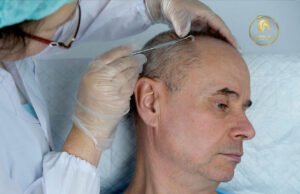Is It Painful to Have a Hair Transplant?

Is It Painful to Have a Hair Transplant?
Hair transplants have become an increasingly popular solution for those struggling with hair loss. The procedure offers a permanent solution by transplanting hair from areas with thick hair (donor area) to the balding or thinning areas.
Despite its growing popularity, many potential patients are concerned about one aspect, which is pain.
This blog aims to address whether hair transplants are painful, explore the different stages of the procedure, and discuss what patients can expect in terms of discomfort and pain management.
Hair Transplant Procedure
The hair transplant procedure is done through two main techniques which are FUE and FUT and it’s done for many reasons such as female hair transplants and head hair transplants. Each technique has its own stages but they have some steps in common. Next, We’ll discuss the stages of the hair transplant procedure.
Administration of Anesthesia
Both FUT and FUE procedures begin with the administration of local anesthesia to numb the donor and recipient areas. This is typically the most uncomfortable part of the procedure, as patients may feel a brief sting or burning sensation when the anesthesia is injected.
However, once the anesthesia takes effect, the areas become numb, and patients generally do not feel any pain during the transplantation process.
What Happens During the Procedure?
During FUT
After the anesthesia has taken effect, the doctor removes a strip of scalp tissue from the donor area. Because the area is numb, patients typically do not feel pain.
Some patients might feel a slight tugging sensation, but it is generally not painful. The donor area is then sutured, and the individual follicular units are taken from the strip and prepared for transplantation.
The recipient area, which is also numbed, receives the transplanted follicles. Throughout this process, patients remain awake and often engage in conversations, watch television, or listen to music.
During FUE
In the FUE process, individual hair follicles are extracted from the donor area using a special tool. The local anesthesia numbs the donor area so patients are comfortable. The extracted follicles are then transplanted into the recipient area.
Similar to FUT, patients are awake and can engage in various activities during the procedure.
Post-Procedure Phase
The level of pain or discomfort experienced after a hair transplant varies among individuals and depends on the type of procedure performed. But mainly, patients say it’s mostly uncomfortable rather than painful.
After FUT
Following the FUT procedure, patients may experience some discomfort in the donor area where the strip of scalp was removed. The sutures can cause a feeling of tightness, and the area might be tender for a few days.
Pain is generally managed with prescribed painkillers and over-the-counter pain medications. Most patients find the discomfort to be tolerable and report that it subsides within a week or two maximum.
After FUE
FUE typically results in less discomfort compared to FUT because it does not involve large incisions or sutures. Patients may experience mild soreness and redness in the donor area, but this usually resolves within a few days. Over-the-counter pain medications are often sufficient to manage any discomfort.
Long-Term Pain Considerations
It’s important to note that hair transplant procedures, whether FUT or FUE, are designed to be minimally invasive. Long-term pain is uncommon. The vast majority of patients recover fully without ongoing pain. The healing process involves some mild discomfort as the transplanted follicles settle and the scalp heals, but this is usually short-lived.
Pain Management Tips
Before the Procedure
During the initial consultation, discuss any concerns about pain with your doctor as expectations can cause you to feel pain that is not there as a result of psychological effects. The doctor can provide detailed information about what to expect and how they manage pain during and after the procedure.
Follow your doctor’s instructions carefully, which may include avoiding certain medications or substances that can increase bleeding or interfere with anesthesia.
During the Procedure
The use of local anesthesia is a standard practice. Some clinics also offer sedatives to help patients relax during the procedure. Additionally, engaging in activities like watching TV, listening to music, or even reading can help keep your mind off the procedure and reduce any discomfort you might feel.
After the Procedure
Use the prescribed painkillers or over-the-counter pain relief as directed by your doctor to avoid any discomfort you might feel. Also, applying ice packs to the treated areas can reduce swelling and provide comfort.
Resting and following post-operative care instructions are crucial for a smooth recovery. Make sure to attend all scheduled follow-up appointments to ensure proper healing and address any concerns.
Psychological Aspects of Pain
Pain perception is not only physical but also psychological. Anxiety and fear can amplify the sensation of pain. Understanding the procedure, knowing what to expect, and having confidence in your doctor can significantly reduce anxiety and perceived pain. Many patients find that their fear of pain is worse than the actual experience.
Patient Experiences
Patient experiences with hair transplants vary, but many report that the pain was much less than anticipated. Here are a few reviews:
- John, 45: “I was really nervous about the pain, especially the injections for the anesthesia. But it was just a small sting, and after that, I didn’t feel much during the procedure. The recovery was smooth, just a bit sore for a few days.”
- Maria, 37: “I chose FUE because I heard it was less painful. The procedure itself was a breeze. Post-op, I had some redness and tenderness, but it was nothing I couldn’t handle with a couple of painkillers.”
- Alex, 50: “The FUT procedure sounded daunting, but the pain was manageable. The tightness from the sutures was the most uncomfortable part, but it improved quickly.”

Conclusion
Hair transplants are generally not painful and they are a great option if you are struggling with hair loss, thinning, or baldness. However, the fear of pain can hold people back from considering it.
While some discomfort is inevitable, especially in the initial recovery period, the procedures are generally well-tolerated.
Both FUT and FUE are designed to minimize pain, ensure patient comfort, and give amazing results of thicker hair and renewed confidence.

When Can You Resume Using Normal.
When Can You Resume Using Normal Shampoo After a Hair Transplant? Undergoing a hair transplant is a significant step towards.
Read More
Hair Transplant in Dubai: Your Complete.
Hair transplant in Dubai has become one of the most sought-after cosmetic procedures for men and women dealing with hair.
Read More
